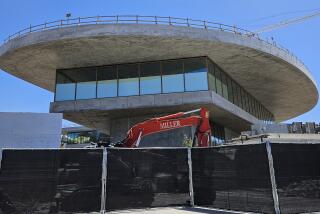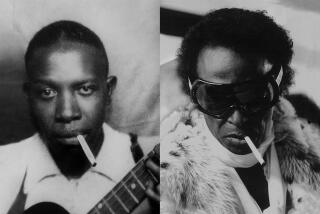Heady Days in Santa Fe
- Share via
Only a month after the Georgia O’Keeffe Museum opened in Santa Fe, N.M., attracting huge crowds and national media attention, the city’s Museum of Indian Arts & Culture/Laboratory of Anthropology is unveiling a $3-million addition.
The Amy Rose Bloch Wing--named for the daughter of longtime museum supporters Richard and Nancy Bloch--opens today, adding 21,000 square feet of display and study space to the 10-year-old facility.
The central attraction is “Here, Now and Always,” a 9,000-square-foot permanent exhibition including 1,300 artworks and artifacts, music and videos. Sixteen authors have contributed text, which illuminates Native American history and culture in storytelling fashion.
Eight years in the making, the new installation is intended to make the museum “less of a mausoleum and more about living people,” Director Bruce Bernstein says.
The new display “breaks down curatorial privilege,” he says, referring to the traditional way of displaying objects from a relatively rigid, scholarly point of view. “You won’t be directed to see art in one way. ‘Here, Now and Always’ sets up an inquiry. You will come away with questions.”
Presenting artworks from the museum’s collection in the context of their creation and use--rather than in tribal categories--the exhibition proceeds through thematic sections: “Ancestors,” “Architecture,” “Language and Song,” “Plants and Animals,” “Exchange,” “Survival” and “The Arts.” Visitors also will see replicas of Native American dwellings and a 1930s trading post.
While gaining a new wing, the building has been transformed from an industrial modern facility to a Santa Fe-style structure more in keeping with the adjacent Laboratory of Anthropology.
With a collection of about 2,500 artworks, 72,000 ethnographic objects and 10 million artifacts, representing 11,670 archeological sites in New Mexico, the museum and laboratory are the foremost repository of the state’s historic indigenous culture. The collection began in 1909 with the founding of the Museum of New Mexico, a state-funded organization that now administers four museums and five state monuments. The laboratory was founded in 1931 and became part of the Museum of New Mexico in 1947.
Forty years later, the Museum of Indian Arts & Culture opened as a showcase for the laboratory’s collection. The new addition was erected with seed money from the state, augmented by funds from the National Endowment for the Humanities, the Museum of New Mexico Foundation and other private sources.
*
MEANWHILE BACK HOME: Los Angeles’ venerable Southwest Museum--which has a much broader collection of Native American art than its name indicates, including California and the Northwest Coast material among its 250,000 artworks and ethnographic objects--is slowly improving its financial picture.
Director Duane King, who arrived in October 1995, reports that the museum has operated in the black for two years, after a long spell of “one deficit after the other.” The formula is simple, he says: “Bring in more money and spend less. Museums are not businesses, but they have to be run in a businesslike manner. We have to live within our means.”
Among other efforts to strengthen the museum, King is recruiting new blood on the board of trustees. One new member is George Boone, a longtime supporter who is also a trustee at the Los Angeles County Museum of Art. Boone’s enthusiasm is exactly what the Southwest needs if it is to have a healthy future, King says.
The museum is still looking for a satellite facility, but the exhibition program continues at the Highland Park site. Two new shows are on view this summer: “New Dimensions: Casas Grandes-Style Pottery,” featuring meticulously crafted works by master potter Juan Quezada and work by younger potters (to Sept. 21); and “Evelyn Hunt Nadeau: WPA Artist at the Southwest Museum, 1936-1937,” a show of 24 watercolors commissioned by the Depression-era Works Progress Administration to document the museum’s collection of Southwestern basketry and pottery.
*
SWISS HONOR: Stephanie Barron, the Los Angeles County Museum of Art’s senior curator of 20th century art and vice president of education and public programs, is widely known for organizing major exhibitions of German Expressionist art, focusing in particular on the effect of Hitler’s reign on the international art community. Now her efforts have been officially recognized in Switzerland. She is the winner of the 1997 Ernst Ludwig Kirchner Prize.
The prize, named for the Swiss painter and funded by the Benvenuta Family Foundation in Vaduz, rewards outstanding research, exhibitions and publications on Kirchner’s work and other aspects of Expressionism. Barron was cited for research and several exhibitions organized during the last decade. She will receive the $32,500 prize Aug. 30 at the Kirchner Museum in Davos.
*
ROTHSCHILD AWARDS: Four California institutions are among 25 winners nationwide of the Judith Rothschild Foundation’s second annual grant awards. The grants will support the work of under-recognized artists who have died within the last 20 years:
* UC Berkeley’s Art Museum, $20,000 for “Transformation: The Art of Joan Brown,” a 1998 retrospective on a Bay Area figurative painter and sculptor.
* Los Angeles’ Museum of Contemporary Art, $15,000 for the acquisition of “Silueta Series in Mexico,” a portfolio of photographs by Cuban American artist Ana Mendieta that will go on view Jan. 25.
* The Mexican Museum in San Francisco, $10,000 for “The Life and Work of Carlos Almaraz, 1941-1989,” an unscheduled exhibition on the L.A.-based artist, and to purchase one of his paintings.
* Cal State Long Beach’s University Art Museum, $5,000 for “Carlotta Corpron: Photographs,” an unscheduled show of photographs created with light reflected by or projected through translucent objects.
The grant program was established by the will of Judith Rothschild, an abstract painter who died in 1993.
More to Read
The biggest entertainment stories
Get our big stories about Hollywood, film, television, music, arts, culture and more right in your inbox as soon as they publish.
You may occasionally receive promotional content from the Los Angeles Times.










